Breastfeeding Policy Analysis: Power, Politics, & Healthcare
VerifiedAdded on 2023/04/19
|14
|4686
|76
Report
AI Summary
This report provides a comprehensive policy analysis of breastfeeding promotion in Australia, focusing on the significance of breastfeeding for infant and maternal health. It begins by outlining the importance of breastfeeding, highlighting statistics on breastfeeding rates and the health risks associated with inadequate breastfeeding. The report then summarizes the Australian Department of Health's 2018 policy on breastfeeding, which aims to address the issue of low exclusive breastfeeding rates and the lack of enforcement of the WHO code on breast milk substitutes. The analysis delves into the problem formulation, identifying factors that hinder breastfeeding, such as lack of knowledge, social norms, embarrassment, lactation problems, and employment challenges. Furthermore, it sets out the objectives and goals of the policy, emphasizing the need to raise awareness, protect the rights of mothers and children, and increase exclusive breastfeeding rates. The report also identifies decision parameters, including prioritizing breastfeeding as a basic human right and ensuring access to necessary resources and support. Finally, it discusses alternative approaches and provides recommendations for improving breastfeeding promotion in Australia, such as implementing stricter regulations on formula marketing, enhancing breastfeeding education and support, and creating more breastfeeding-friendly environments.
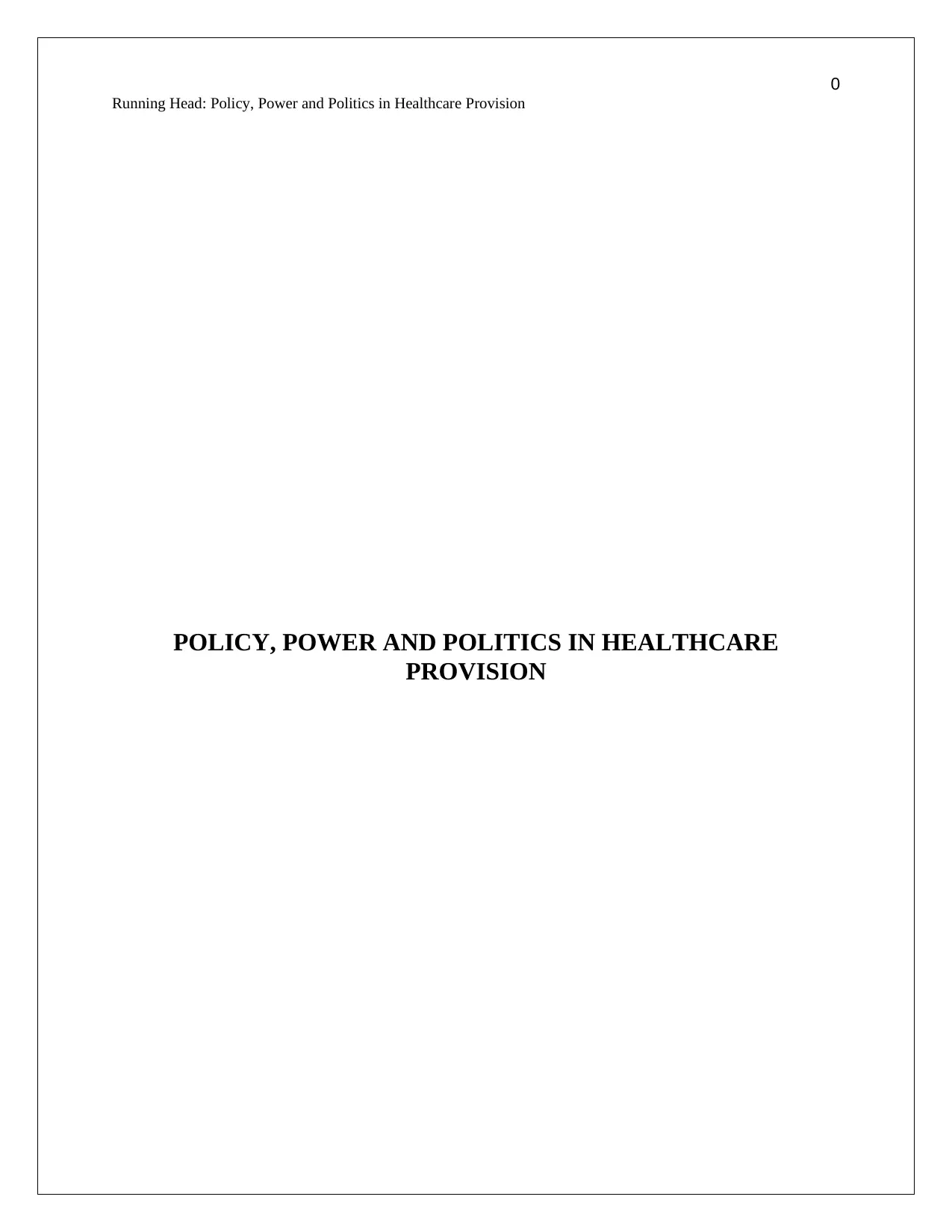
0
Running Head: Policy, Power and Politics in Healthcare Provision
POLICY, POWER AND POLITICS IN HEALTHCARE
PROVISION
Running Head: Policy, Power and Politics in Healthcare Provision
POLICY, POWER AND POLITICS IN HEALTHCARE
PROVISION
Paraphrase This Document
Need a fresh take? Get an instant paraphrase of this document with our AI Paraphraser
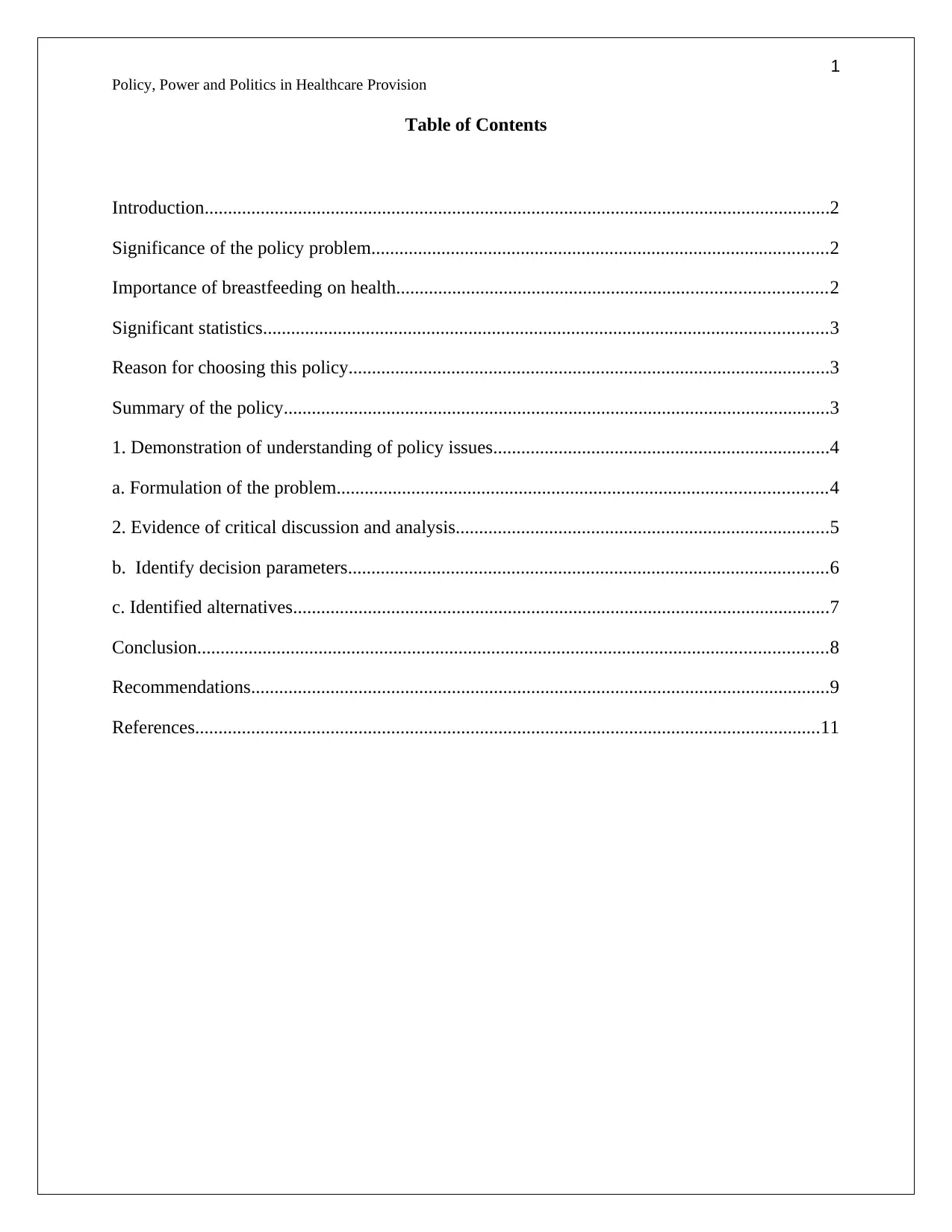
1
Policy, Power and Politics in Healthcare Provision
Table of Contents
Introduction......................................................................................................................................2
Significance of the policy problem..................................................................................................2
Importance of breastfeeding on health............................................................................................2
Significant statistics.........................................................................................................................3
Reason for choosing this policy.......................................................................................................3
Summary of the policy.....................................................................................................................3
1. Demonstration of understanding of policy issues........................................................................4
a. Formulation of the problem.........................................................................................................4
2. Evidence of critical discussion and analysis................................................................................5
b. Identify decision parameters.......................................................................................................6
c. Identified alternatives...................................................................................................................7
Conclusion.......................................................................................................................................8
Recommendations............................................................................................................................9
References......................................................................................................................................11
Policy, Power and Politics in Healthcare Provision
Table of Contents
Introduction......................................................................................................................................2
Significance of the policy problem..................................................................................................2
Importance of breastfeeding on health............................................................................................2
Significant statistics.........................................................................................................................3
Reason for choosing this policy.......................................................................................................3
Summary of the policy.....................................................................................................................3
1. Demonstration of understanding of policy issues........................................................................4
a. Formulation of the problem.........................................................................................................4
2. Evidence of critical discussion and analysis................................................................................5
b. Identify decision parameters.......................................................................................................6
c. Identified alternatives...................................................................................................................7
Conclusion.......................................................................................................................................8
Recommendations............................................................................................................................9
References......................................................................................................................................11
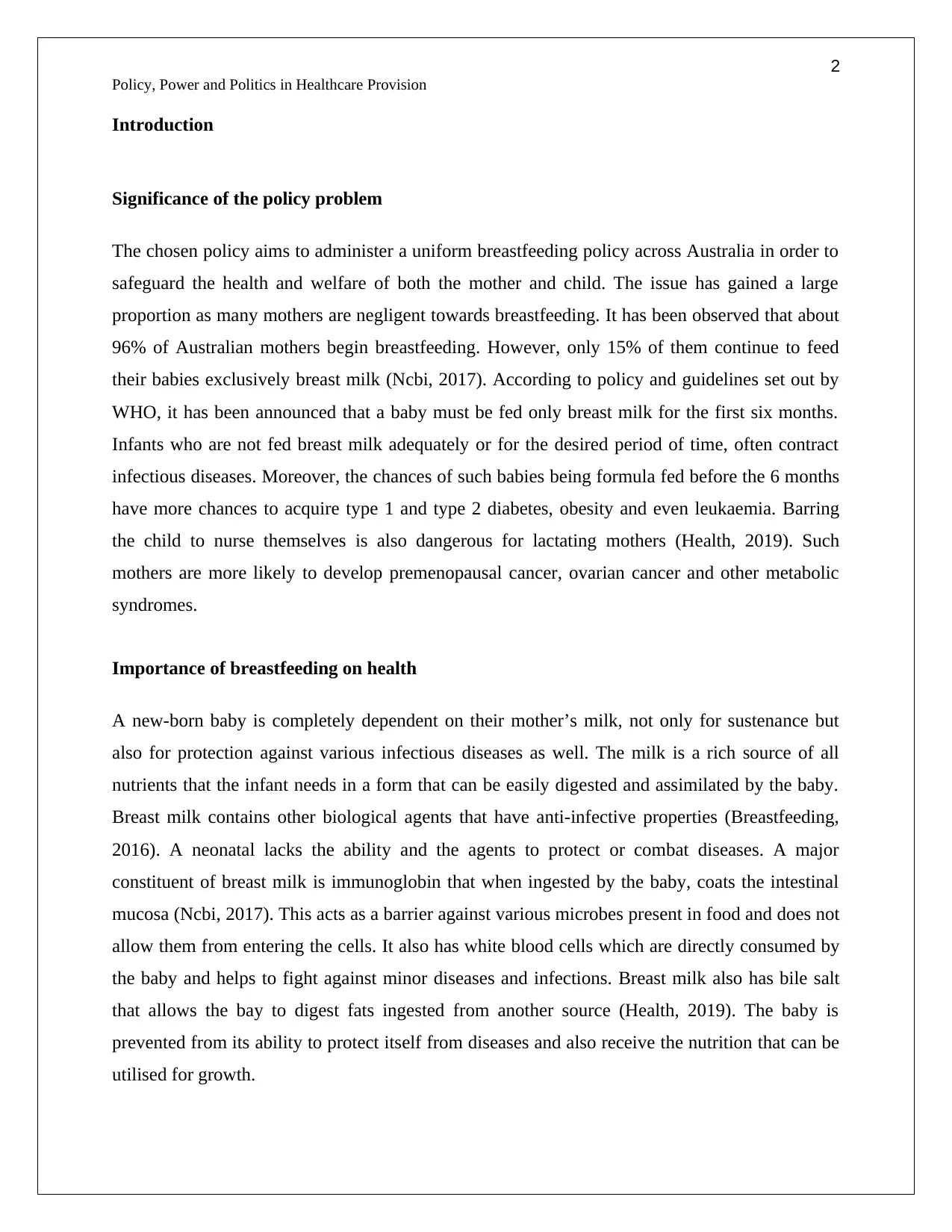
2
Policy, Power and Politics in Healthcare Provision
Introduction
Significance of the policy problem
The chosen policy aims to administer a uniform breastfeeding policy across Australia in order to
safeguard the health and welfare of both the mother and child. The issue has gained a large
proportion as many mothers are negligent towards breastfeeding. It has been observed that about
96% of Australian mothers begin breastfeeding. However, only 15% of them continue to feed
their babies exclusively breast milk (Ncbi, 2017). According to policy and guidelines set out by
WHO, it has been announced that a baby must be fed only breast milk for the first six months.
Infants who are not fed breast milk adequately or for the desired period of time, often contract
infectious diseases. Moreover, the chances of such babies being formula fed before the 6 months
have more chances to acquire type 1 and type 2 diabetes, obesity and even leukaemia. Barring
the child to nurse themselves is also dangerous for lactating mothers (Health, 2019). Such
mothers are more likely to develop premenopausal cancer, ovarian cancer and other metabolic
syndromes.
Importance of breastfeeding on health
A new-born baby is completely dependent on their mother’s milk, not only for sustenance but
also for protection against various infectious diseases as well. The milk is a rich source of all
nutrients that the infant needs in a form that can be easily digested and assimilated by the baby.
Breast milk contains other biological agents that have anti-infective properties (Breastfeeding,
2016). A neonatal lacks the ability and the agents to protect or combat diseases. A major
constituent of breast milk is immunoglobin that when ingested by the baby, coats the intestinal
mucosa (Ncbi, 2017). This acts as a barrier against various microbes present in food and does not
allow them from entering the cells. It also has white blood cells which are directly consumed by
the baby and helps to fight against minor diseases and infections. Breast milk also has bile salt
that allows the bay to digest fats ingested from another source (Health, 2019). The baby is
prevented from its ability to protect itself from diseases and also receive the nutrition that can be
utilised for growth.
Policy, Power and Politics in Healthcare Provision
Introduction
Significance of the policy problem
The chosen policy aims to administer a uniform breastfeeding policy across Australia in order to
safeguard the health and welfare of both the mother and child. The issue has gained a large
proportion as many mothers are negligent towards breastfeeding. It has been observed that about
96% of Australian mothers begin breastfeeding. However, only 15% of them continue to feed
their babies exclusively breast milk (Ncbi, 2017). According to policy and guidelines set out by
WHO, it has been announced that a baby must be fed only breast milk for the first six months.
Infants who are not fed breast milk adequately or for the desired period of time, often contract
infectious diseases. Moreover, the chances of such babies being formula fed before the 6 months
have more chances to acquire type 1 and type 2 diabetes, obesity and even leukaemia. Barring
the child to nurse themselves is also dangerous for lactating mothers (Health, 2019). Such
mothers are more likely to develop premenopausal cancer, ovarian cancer and other metabolic
syndromes.
Importance of breastfeeding on health
A new-born baby is completely dependent on their mother’s milk, not only for sustenance but
also for protection against various infectious diseases as well. The milk is a rich source of all
nutrients that the infant needs in a form that can be easily digested and assimilated by the baby.
Breast milk contains other biological agents that have anti-infective properties (Breastfeeding,
2016). A neonatal lacks the ability and the agents to protect or combat diseases. A major
constituent of breast milk is immunoglobin that when ingested by the baby, coats the intestinal
mucosa (Ncbi, 2017). This acts as a barrier against various microbes present in food and does not
allow them from entering the cells. It also has white blood cells which are directly consumed by
the baby and helps to fight against minor diseases and infections. Breast milk also has bile salt
that allows the bay to digest fats ingested from another source (Health, 2019). The baby is
prevented from its ability to protect itself from diseases and also receive the nutrition that can be
utilised for growth.
⊘ This is a preview!⊘
Do you want full access?
Subscribe today to unlock all pages.

Trusted by 1+ million students worldwide
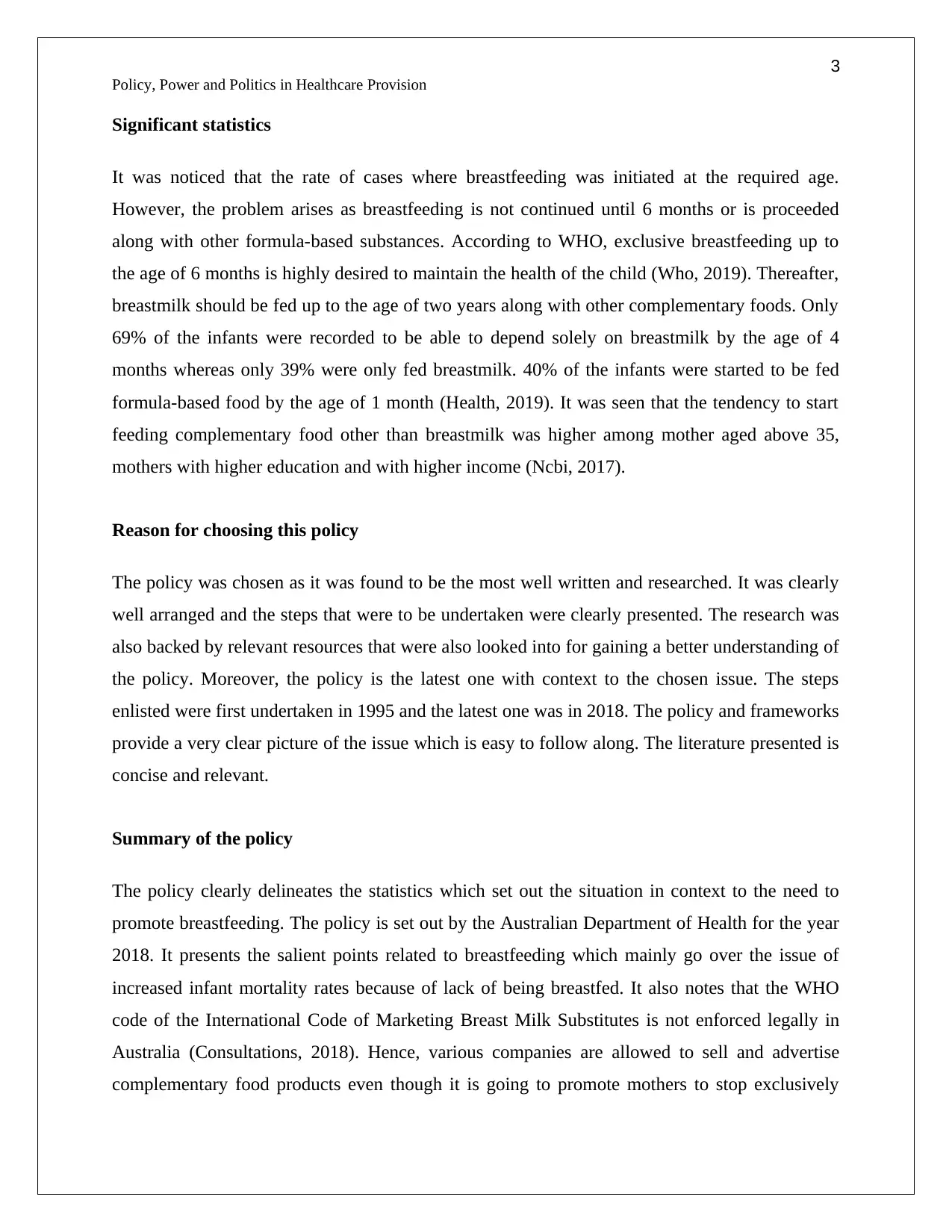
3
Policy, Power and Politics in Healthcare Provision
Significant statistics
It was noticed that the rate of cases where breastfeeding was initiated at the required age.
However, the problem arises as breastfeeding is not continued until 6 months or is proceeded
along with other formula-based substances. According to WHO, exclusive breastfeeding up to
the age of 6 months is highly desired to maintain the health of the child (Who, 2019). Thereafter,
breastmilk should be fed up to the age of two years along with other complementary foods. Only
69% of the infants were recorded to be able to depend solely on breastmilk by the age of 4
months whereas only 39% were only fed breastmilk. 40% of the infants were started to be fed
formula-based food by the age of 1 month (Health, 2019). It was seen that the tendency to start
feeding complementary food other than breastmilk was higher among mother aged above 35,
mothers with higher education and with higher income (Ncbi, 2017).
Reason for choosing this policy
The policy was chosen as it was found to be the most well written and researched. It was clearly
well arranged and the steps that were to be undertaken were clearly presented. The research was
also backed by relevant resources that were also looked into for gaining a better understanding of
the policy. Moreover, the policy is the latest one with context to the chosen issue. The steps
enlisted were first undertaken in 1995 and the latest one was in 2018. The policy and frameworks
provide a very clear picture of the issue which is easy to follow along. The literature presented is
concise and relevant.
Summary of the policy
The policy clearly delineates the statistics which set out the situation in context to the need to
promote breastfeeding. The policy is set out by the Australian Department of Health for the year
2018. It presents the salient points related to breastfeeding which mainly go over the issue of
increased infant mortality rates because of lack of being breastfed. It also notes that the WHO
code of the International Code of Marketing Breast Milk Substitutes is not enforced legally in
Australia (Consultations, 2018). Hence, various companies are allowed to sell and advertise
complementary food products even though it is going to promote mothers to stop exclusively
Policy, Power and Politics in Healthcare Provision
Significant statistics
It was noticed that the rate of cases where breastfeeding was initiated at the required age.
However, the problem arises as breastfeeding is not continued until 6 months or is proceeded
along with other formula-based substances. According to WHO, exclusive breastfeeding up to
the age of 6 months is highly desired to maintain the health of the child (Who, 2019). Thereafter,
breastmilk should be fed up to the age of two years along with other complementary foods. Only
69% of the infants were recorded to be able to depend solely on breastmilk by the age of 4
months whereas only 39% were only fed breastmilk. 40% of the infants were started to be fed
formula-based food by the age of 1 month (Health, 2019). It was seen that the tendency to start
feeding complementary food other than breastmilk was higher among mother aged above 35,
mothers with higher education and with higher income (Ncbi, 2017).
Reason for choosing this policy
The policy was chosen as it was found to be the most well written and researched. It was clearly
well arranged and the steps that were to be undertaken were clearly presented. The research was
also backed by relevant resources that were also looked into for gaining a better understanding of
the policy. Moreover, the policy is the latest one with context to the chosen issue. The steps
enlisted were first undertaken in 1995 and the latest one was in 2018. The policy and frameworks
provide a very clear picture of the issue which is easy to follow along. The literature presented is
concise and relevant.
Summary of the policy
The policy clearly delineates the statistics which set out the situation in context to the need to
promote breastfeeding. The policy is set out by the Australian Department of Health for the year
2018. It presents the salient points related to breastfeeding which mainly go over the issue of
increased infant mortality rates because of lack of being breastfed. It also notes that the WHO
code of the International Code of Marketing Breast Milk Substitutes is not enforced legally in
Australia (Consultations, 2018). Hence, various companies are allowed to sell and advertise
complementary food products even though it is going to promote mothers to stop exclusively
Paraphrase This Document
Need a fresh take? Get an instant paraphrase of this document with our AI Paraphraser
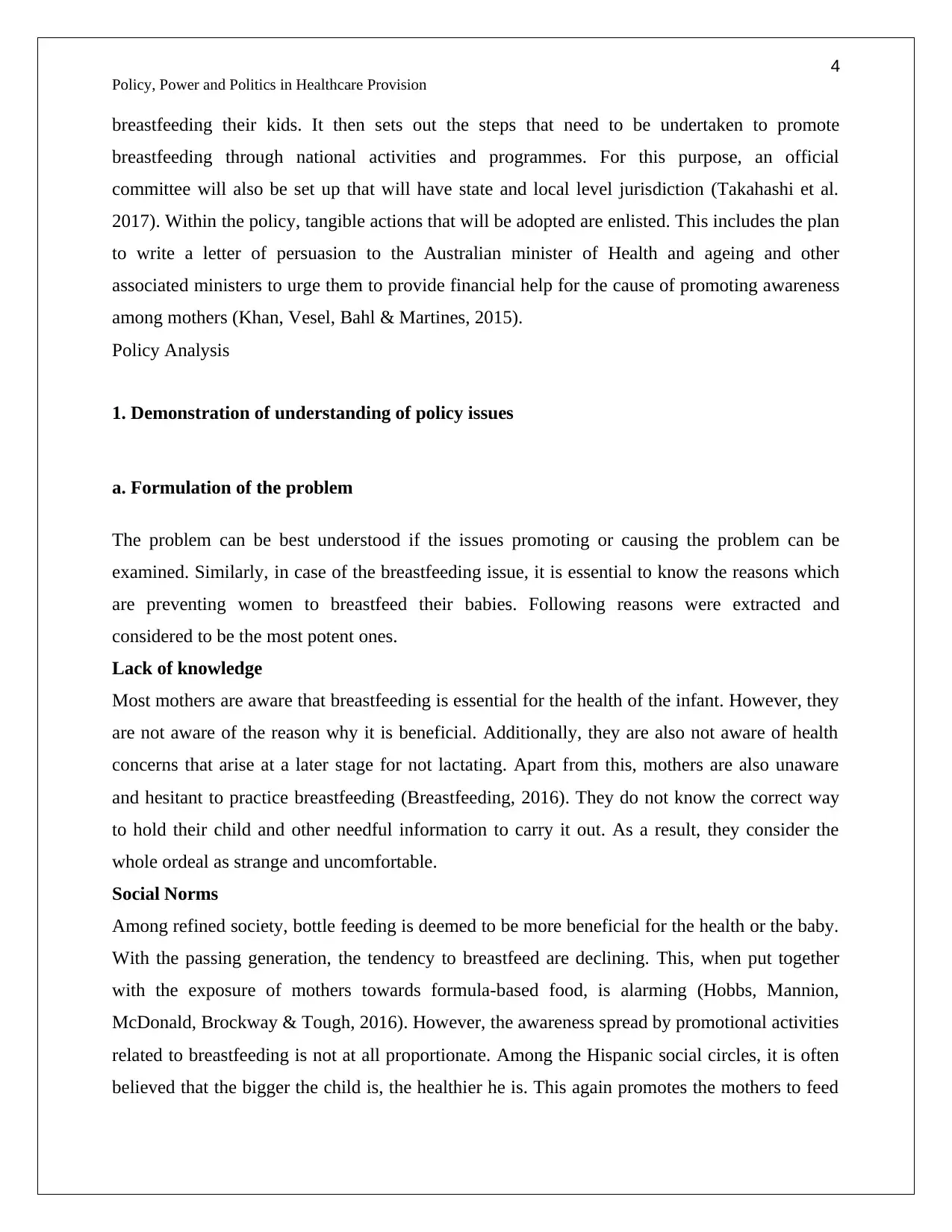
4
Policy, Power and Politics in Healthcare Provision
breastfeeding their kids. It then sets out the steps that need to be undertaken to promote
breastfeeding through national activities and programmes. For this purpose, an official
committee will also be set up that will have state and local level jurisdiction (Takahashi et al.
2017). Within the policy, tangible actions that will be adopted are enlisted. This includes the plan
to write a letter of persuasion to the Australian minister of Health and ageing and other
associated ministers to urge them to provide financial help for the cause of promoting awareness
among mothers (Khan, Vesel, Bahl & Martines, 2015).
Policy Analysis
1. Demonstration of understanding of policy issues
a. Formulation of the problem
The problem can be best understood if the issues promoting or causing the problem can be
examined. Similarly, in case of the breastfeeding issue, it is essential to know the reasons which
are preventing women to breastfeed their babies. Following reasons were extracted and
considered to be the most potent ones.
Lack of knowledge
Most mothers are aware that breastfeeding is essential for the health of the infant. However, they
are not aware of the reason why it is beneficial. Additionally, they are also not aware of health
concerns that arise at a later stage for not lactating. Apart from this, mothers are also unaware
and hesitant to practice breastfeeding (Breastfeeding, 2016). They do not know the correct way
to hold their child and other needful information to carry it out. As a result, they consider the
whole ordeal as strange and uncomfortable.
Social Norms
Among refined society, bottle feeding is deemed to be more beneficial for the health or the baby.
With the passing generation, the tendency to breastfeed are declining. This, when put together
with the exposure of mothers towards formula-based food, is alarming (Hobbs, Mannion,
McDonald, Brockway & Tough, 2016). However, the awareness spread by promotional activities
related to breastfeeding is not at all proportionate. Among the Hispanic social circles, it is often
believed that the bigger the child is, the healthier he is. This again promotes the mothers to feed
Policy, Power and Politics in Healthcare Provision
breastfeeding their kids. It then sets out the steps that need to be undertaken to promote
breastfeeding through national activities and programmes. For this purpose, an official
committee will also be set up that will have state and local level jurisdiction (Takahashi et al.
2017). Within the policy, tangible actions that will be adopted are enlisted. This includes the plan
to write a letter of persuasion to the Australian minister of Health and ageing and other
associated ministers to urge them to provide financial help for the cause of promoting awareness
among mothers (Khan, Vesel, Bahl & Martines, 2015).
Policy Analysis
1. Demonstration of understanding of policy issues
a. Formulation of the problem
The problem can be best understood if the issues promoting or causing the problem can be
examined. Similarly, in case of the breastfeeding issue, it is essential to know the reasons which
are preventing women to breastfeed their babies. Following reasons were extracted and
considered to be the most potent ones.
Lack of knowledge
Most mothers are aware that breastfeeding is essential for the health of the infant. However, they
are not aware of the reason why it is beneficial. Additionally, they are also not aware of health
concerns that arise at a later stage for not lactating. Apart from this, mothers are also unaware
and hesitant to practice breastfeeding (Breastfeeding, 2016). They do not know the correct way
to hold their child and other needful information to carry it out. As a result, they consider the
whole ordeal as strange and uncomfortable.
Social Norms
Among refined society, bottle feeding is deemed to be more beneficial for the health or the baby.
With the passing generation, the tendency to breastfeed are declining. This, when put together
with the exposure of mothers towards formula-based food, is alarming (Hobbs, Mannion,
McDonald, Brockway & Tough, 2016). However, the awareness spread by promotional activities
related to breastfeeding is not at all proportionate. Among the Hispanic social circles, it is often
believed that the bigger the child is, the healthier he is. This again promotes the mothers to feed
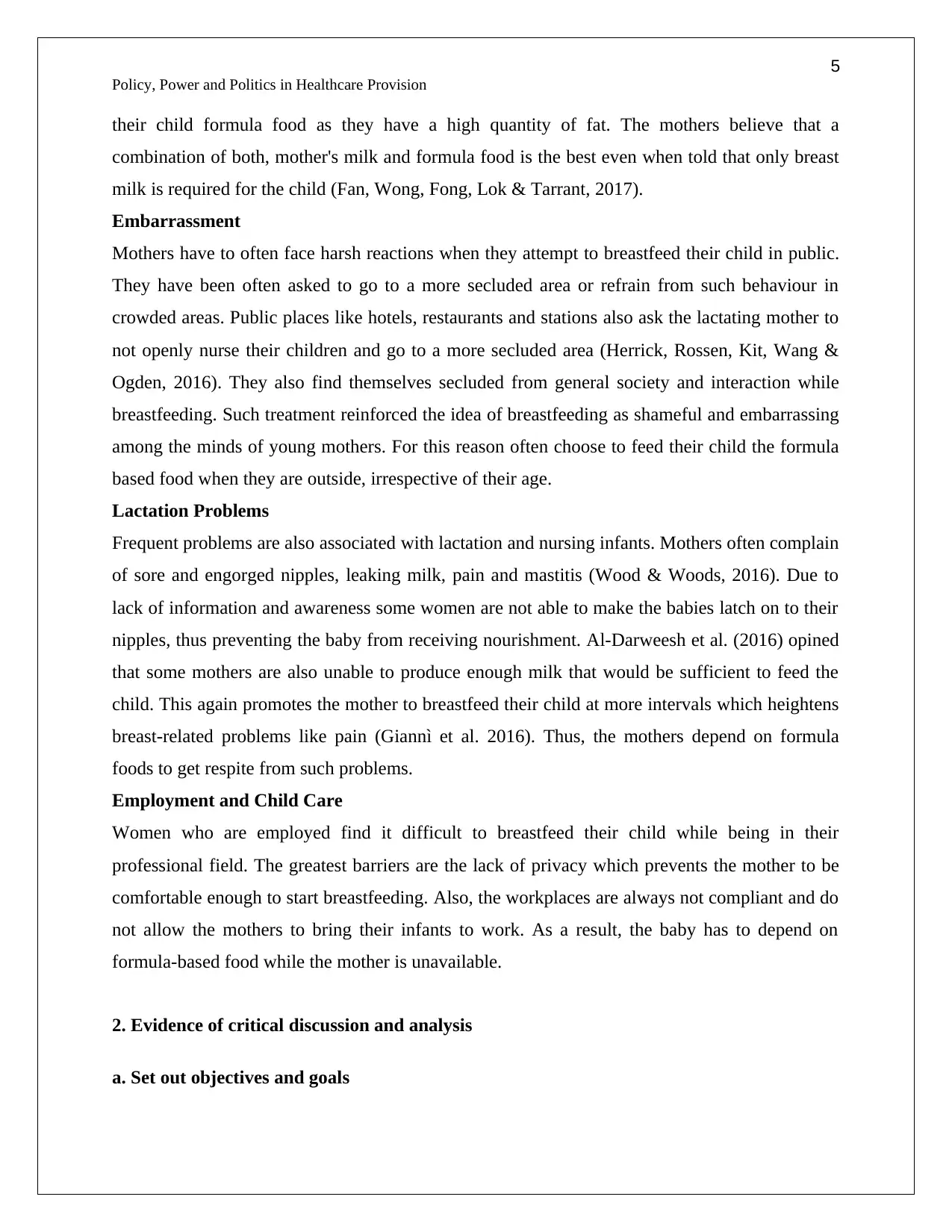
5
Policy, Power and Politics in Healthcare Provision
their child formula food as they have a high quantity of fat. The mothers believe that a
combination of both, mother's milk and formula food is the best even when told that only breast
milk is required for the child (Fan, Wong, Fong, Lok & Tarrant, 2017).
Embarrassment
Mothers have to often face harsh reactions when they attempt to breastfeed their child in public.
They have been often asked to go to a more secluded area or refrain from such behaviour in
crowded areas. Public places like hotels, restaurants and stations also ask the lactating mother to
not openly nurse their children and go to a more secluded area (Herrick, Rossen, Kit, Wang &
Ogden, 2016). They also find themselves secluded from general society and interaction while
breastfeeding. Such treatment reinforced the idea of breastfeeding as shameful and embarrassing
among the minds of young mothers. For this reason often choose to feed their child the formula
based food when they are outside, irrespective of their age.
Lactation Problems
Frequent problems are also associated with lactation and nursing infants. Mothers often complain
of sore and engorged nipples, leaking milk, pain and mastitis (Wood & Woods, 2016). Due to
lack of information and awareness some women are not able to make the babies latch on to their
nipples, thus preventing the baby from receiving nourishment. Al-Darweesh et al. (2016) opined
that some mothers are also unable to produce enough milk that would be sufficient to feed the
child. This again promotes the mother to breastfeed their child at more intervals which heightens
breast-related problems like pain (Giannì et al. 2016). Thus, the mothers depend on formula
foods to get respite from such problems.
Employment and Child Care
Women who are employed find it difficult to breastfeed their child while being in their
professional field. The greatest barriers are the lack of privacy which prevents the mother to be
comfortable enough to start breastfeeding. Also, the workplaces are always not compliant and do
not allow the mothers to bring their infants to work. As a result, the baby has to depend on
formula-based food while the mother is unavailable.
2. Evidence of critical discussion and analysis
a. Set out objectives and goals
Policy, Power and Politics in Healthcare Provision
their child formula food as they have a high quantity of fat. The mothers believe that a
combination of both, mother's milk and formula food is the best even when told that only breast
milk is required for the child (Fan, Wong, Fong, Lok & Tarrant, 2017).
Embarrassment
Mothers have to often face harsh reactions when they attempt to breastfeed their child in public.
They have been often asked to go to a more secluded area or refrain from such behaviour in
crowded areas. Public places like hotels, restaurants and stations also ask the lactating mother to
not openly nurse their children and go to a more secluded area (Herrick, Rossen, Kit, Wang &
Ogden, 2016). They also find themselves secluded from general society and interaction while
breastfeeding. Such treatment reinforced the idea of breastfeeding as shameful and embarrassing
among the minds of young mothers. For this reason often choose to feed their child the formula
based food when they are outside, irrespective of their age.
Lactation Problems
Frequent problems are also associated with lactation and nursing infants. Mothers often complain
of sore and engorged nipples, leaking milk, pain and mastitis (Wood & Woods, 2016). Due to
lack of information and awareness some women are not able to make the babies latch on to their
nipples, thus preventing the baby from receiving nourishment. Al-Darweesh et al. (2016) opined
that some mothers are also unable to produce enough milk that would be sufficient to feed the
child. This again promotes the mother to breastfeed their child at more intervals which heightens
breast-related problems like pain (Giannì et al. 2016). Thus, the mothers depend on formula
foods to get respite from such problems.
Employment and Child Care
Women who are employed find it difficult to breastfeed their child while being in their
professional field. The greatest barriers are the lack of privacy which prevents the mother to be
comfortable enough to start breastfeeding. Also, the workplaces are always not compliant and do
not allow the mothers to bring their infants to work. As a result, the baby has to depend on
formula-based food while the mother is unavailable.
2. Evidence of critical discussion and analysis
a. Set out objectives and goals
⊘ This is a preview!⊘
Do you want full access?
Subscribe today to unlock all pages.

Trusted by 1+ million students worldwide
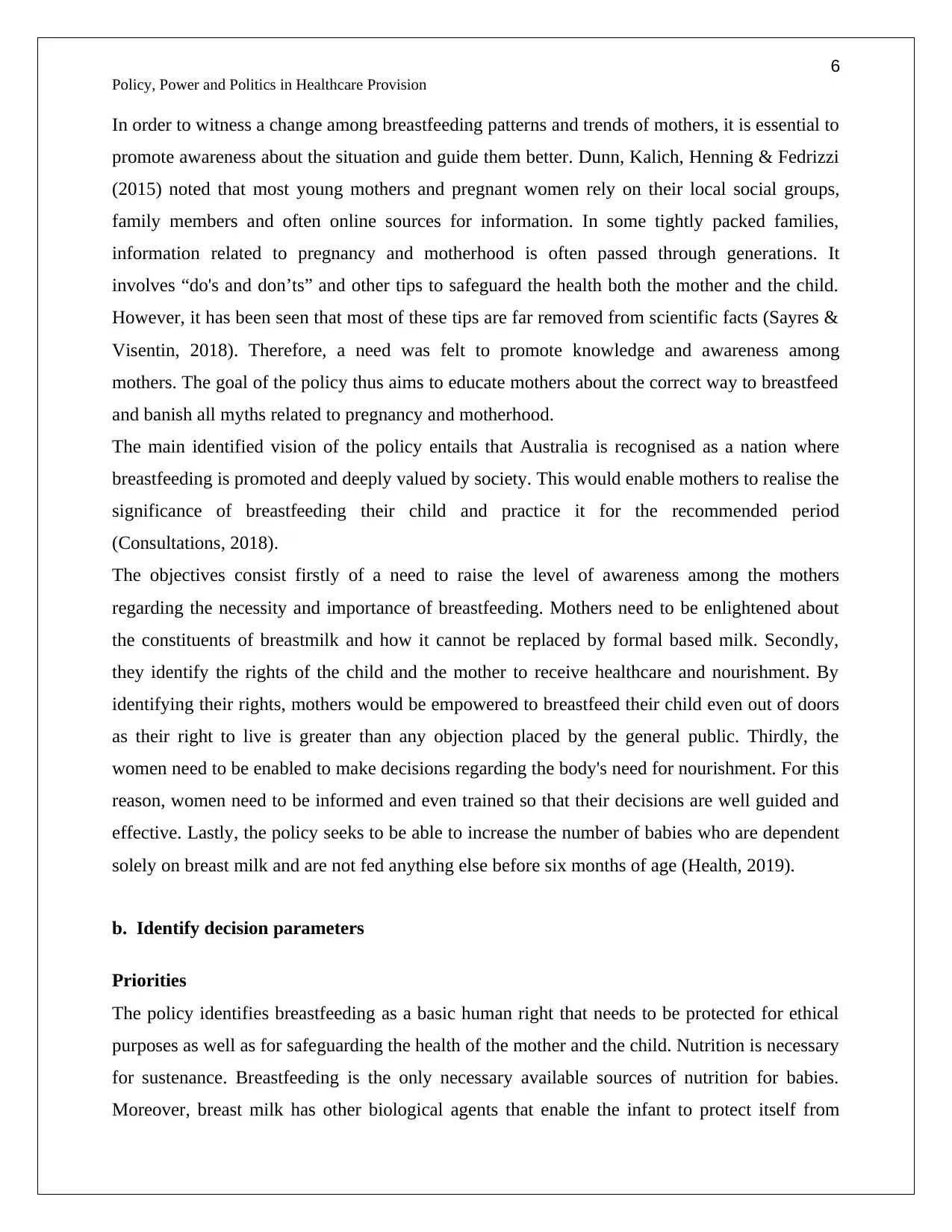
6
Policy, Power and Politics in Healthcare Provision
In order to witness a change among breastfeeding patterns and trends of mothers, it is essential to
promote awareness about the situation and guide them better. Dunn, Kalich, Henning & Fedrizzi
(2015) noted that most young mothers and pregnant women rely on their local social groups,
family members and often online sources for information. In some tightly packed families,
information related to pregnancy and motherhood is often passed through generations. It
involves “do's and don’ts” and other tips to safeguard the health both the mother and the child.
However, it has been seen that most of these tips are far removed from scientific facts (Sayres &
Visentin, 2018). Therefore, a need was felt to promote knowledge and awareness among
mothers. The goal of the policy thus aims to educate mothers about the correct way to breastfeed
and banish all myths related to pregnancy and motherhood.
The main identified vision of the policy entails that Australia is recognised as a nation where
breastfeeding is promoted and deeply valued by society. This would enable mothers to realise the
significance of breastfeeding their child and practice it for the recommended period
(Consultations, 2018).
The objectives consist firstly of a need to raise the level of awareness among the mothers
regarding the necessity and importance of breastfeeding. Mothers need to be enlightened about
the constituents of breastmilk and how it cannot be replaced by formal based milk. Secondly,
they identify the rights of the child and the mother to receive healthcare and nourishment. By
identifying their rights, mothers would be empowered to breastfeed their child even out of doors
as their right to live is greater than any objection placed by the general public. Thirdly, the
women need to be enabled to make decisions regarding the body's need for nourishment. For this
reason, women need to be informed and even trained so that their decisions are well guided and
effective. Lastly, the policy seeks to be able to increase the number of babies who are dependent
solely on breast milk and are not fed anything else before six months of age (Health, 2019).
b. Identify decision parameters
Priorities
The policy identifies breastfeeding as a basic human right that needs to be protected for ethical
purposes as well as for safeguarding the health of the mother and the child. Nutrition is necessary
for sustenance. Breastfeeding is the only necessary available sources of nutrition for babies.
Moreover, breast milk has other biological agents that enable the infant to protect itself from
Policy, Power and Politics in Healthcare Provision
In order to witness a change among breastfeeding patterns and trends of mothers, it is essential to
promote awareness about the situation and guide them better. Dunn, Kalich, Henning & Fedrizzi
(2015) noted that most young mothers and pregnant women rely on their local social groups,
family members and often online sources for information. In some tightly packed families,
information related to pregnancy and motherhood is often passed through generations. It
involves “do's and don’ts” and other tips to safeguard the health both the mother and the child.
However, it has been seen that most of these tips are far removed from scientific facts (Sayres &
Visentin, 2018). Therefore, a need was felt to promote knowledge and awareness among
mothers. The goal of the policy thus aims to educate mothers about the correct way to breastfeed
and banish all myths related to pregnancy and motherhood.
The main identified vision of the policy entails that Australia is recognised as a nation where
breastfeeding is promoted and deeply valued by society. This would enable mothers to realise the
significance of breastfeeding their child and practice it for the recommended period
(Consultations, 2018).
The objectives consist firstly of a need to raise the level of awareness among the mothers
regarding the necessity and importance of breastfeeding. Mothers need to be enlightened about
the constituents of breastmilk and how it cannot be replaced by formal based milk. Secondly,
they identify the rights of the child and the mother to receive healthcare and nourishment. By
identifying their rights, mothers would be empowered to breastfeed their child even out of doors
as their right to live is greater than any objection placed by the general public. Thirdly, the
women need to be enabled to make decisions regarding the body's need for nourishment. For this
reason, women need to be informed and even trained so that their decisions are well guided and
effective. Lastly, the policy seeks to be able to increase the number of babies who are dependent
solely on breast milk and are not fed anything else before six months of age (Health, 2019).
b. Identify decision parameters
Priorities
The policy identifies breastfeeding as a basic human right that needs to be protected for ethical
purposes as well as for safeguarding the health of the mother and the child. Nutrition is necessary
for sustenance. Breastfeeding is the only necessary available sources of nutrition for babies.
Moreover, breast milk has other biological agents that enable the infant to protect itself from
Paraphrase This Document
Need a fresh take? Get an instant paraphrase of this document with our AI Paraphraser
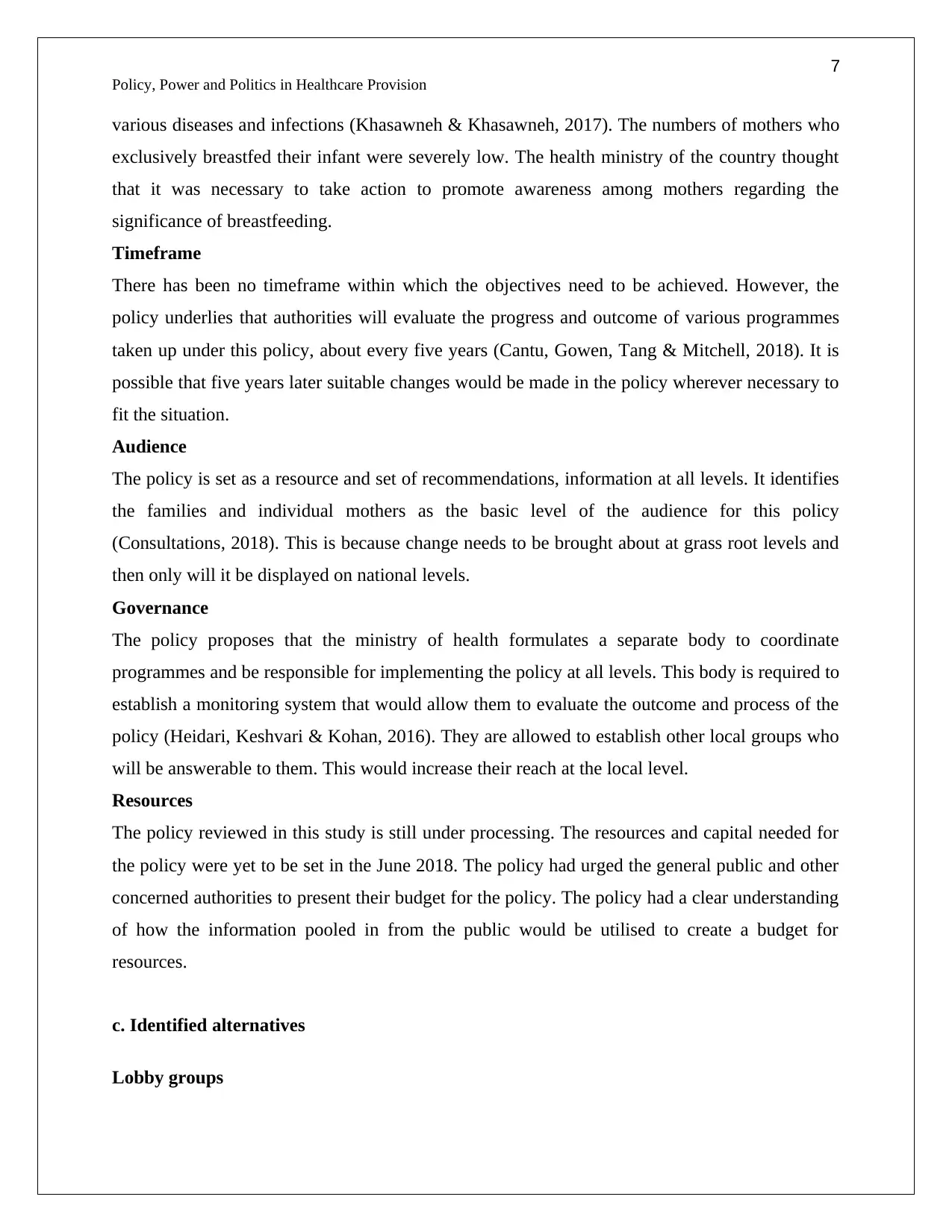
7
Policy, Power and Politics in Healthcare Provision
various diseases and infections (Khasawneh & Khasawneh, 2017). The numbers of mothers who
exclusively breastfed their infant were severely low. The health ministry of the country thought
that it was necessary to take action to promote awareness among mothers regarding the
significance of breastfeeding.
Timeframe
There has been no timeframe within which the objectives need to be achieved. However, the
policy underlies that authorities will evaluate the progress and outcome of various programmes
taken up under this policy, about every five years (Cantu, Gowen, Tang & Mitchell, 2018). It is
possible that five years later suitable changes would be made in the policy wherever necessary to
fit the situation.
Audience
The policy is set as a resource and set of recommendations, information at all levels. It identifies
the families and individual mothers as the basic level of the audience for this policy
(Consultations, 2018). This is because change needs to be brought about at grass root levels and
then only will it be displayed on national levels.
Governance
The policy proposes that the ministry of health formulates a separate body to coordinate
programmes and be responsible for implementing the policy at all levels. This body is required to
establish a monitoring system that would allow them to evaluate the outcome and process of the
policy (Heidari, Keshvari & Kohan, 2016). They are allowed to establish other local groups who
will be answerable to them. This would increase their reach at the local level.
Resources
The policy reviewed in this study is still under processing. The resources and capital needed for
the policy were yet to be set in the June 2018. The policy had urged the general public and other
concerned authorities to present their budget for the policy. The policy had a clear understanding
of how the information pooled in from the public would be utilised to create a budget for
resources.
c. Identified alternatives
Lobby groups
Policy, Power and Politics in Healthcare Provision
various diseases and infections (Khasawneh & Khasawneh, 2017). The numbers of mothers who
exclusively breastfed their infant were severely low. The health ministry of the country thought
that it was necessary to take action to promote awareness among mothers regarding the
significance of breastfeeding.
Timeframe
There has been no timeframe within which the objectives need to be achieved. However, the
policy underlies that authorities will evaluate the progress and outcome of various programmes
taken up under this policy, about every five years (Cantu, Gowen, Tang & Mitchell, 2018). It is
possible that five years later suitable changes would be made in the policy wherever necessary to
fit the situation.
Audience
The policy is set as a resource and set of recommendations, information at all levels. It identifies
the families and individual mothers as the basic level of the audience for this policy
(Consultations, 2018). This is because change needs to be brought about at grass root levels and
then only will it be displayed on national levels.
Governance
The policy proposes that the ministry of health formulates a separate body to coordinate
programmes and be responsible for implementing the policy at all levels. This body is required to
establish a monitoring system that would allow them to evaluate the outcome and process of the
policy (Heidari, Keshvari & Kohan, 2016). They are allowed to establish other local groups who
will be answerable to them. This would increase their reach at the local level.
Resources
The policy reviewed in this study is still under processing. The resources and capital needed for
the policy were yet to be set in the June 2018. The policy had urged the general public and other
concerned authorities to present their budget for the policy. The policy had a clear understanding
of how the information pooled in from the public would be utilised to create a budget for
resources.
c. Identified alternatives
Lobby groups
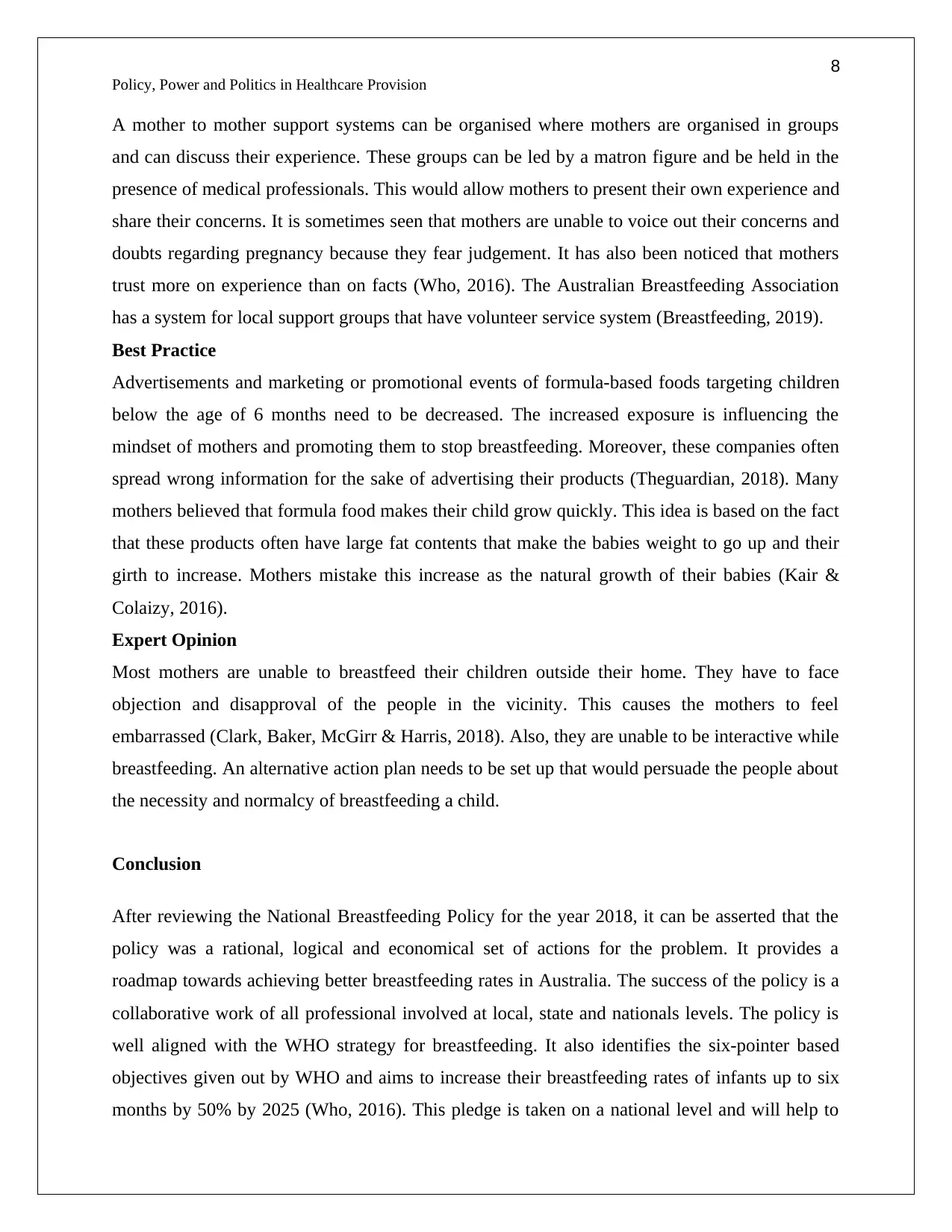
8
Policy, Power and Politics in Healthcare Provision
A mother to mother support systems can be organised where mothers are organised in groups
and can discuss their experience. These groups can be led by a matron figure and be held in the
presence of medical professionals. This would allow mothers to present their own experience and
share their concerns. It is sometimes seen that mothers are unable to voice out their concerns and
doubts regarding pregnancy because they fear judgement. It has also been noticed that mothers
trust more on experience than on facts (Who, 2016). The Australian Breastfeeding Association
has a system for local support groups that have volunteer service system (Breastfeeding, 2019).
Best Practice
Advertisements and marketing or promotional events of formula-based foods targeting children
below the age of 6 months need to be decreased. The increased exposure is influencing the
mindset of mothers and promoting them to stop breastfeeding. Moreover, these companies often
spread wrong information for the sake of advertising their products (Theguardian, 2018). Many
mothers believed that formula food makes their child grow quickly. This idea is based on the fact
that these products often have large fat contents that make the babies weight to go up and their
girth to increase. Mothers mistake this increase as the natural growth of their babies (Kair &
Colaizy, 2016).
Expert Opinion
Most mothers are unable to breastfeed their children outside their home. They have to face
objection and disapproval of the people in the vicinity. This causes the mothers to feel
embarrassed (Clark, Baker, McGirr & Harris, 2018). Also, they are unable to be interactive while
breastfeeding. An alternative action plan needs to be set up that would persuade the people about
the necessity and normalcy of breastfeeding a child.
Conclusion
After reviewing the National Breastfeeding Policy for the year 2018, it can be asserted that the
policy was a rational, logical and economical set of actions for the problem. It provides a
roadmap towards achieving better breastfeeding rates in Australia. The success of the policy is a
collaborative work of all professional involved at local, state and nationals levels. The policy is
well aligned with the WHO strategy for breastfeeding. It also identifies the six-pointer based
objectives given out by WHO and aims to increase their breastfeeding rates of infants up to six
months by 50% by 2025 (Who, 2016). This pledge is taken on a national level and will help to
Policy, Power and Politics in Healthcare Provision
A mother to mother support systems can be organised where mothers are organised in groups
and can discuss their experience. These groups can be led by a matron figure and be held in the
presence of medical professionals. This would allow mothers to present their own experience and
share their concerns. It is sometimes seen that mothers are unable to voice out their concerns and
doubts regarding pregnancy because they fear judgement. It has also been noticed that mothers
trust more on experience than on facts (Who, 2016). The Australian Breastfeeding Association
has a system for local support groups that have volunteer service system (Breastfeeding, 2019).
Best Practice
Advertisements and marketing or promotional events of formula-based foods targeting children
below the age of 6 months need to be decreased. The increased exposure is influencing the
mindset of mothers and promoting them to stop breastfeeding. Moreover, these companies often
spread wrong information for the sake of advertising their products (Theguardian, 2018). Many
mothers believed that formula food makes their child grow quickly. This idea is based on the fact
that these products often have large fat contents that make the babies weight to go up and their
girth to increase. Mothers mistake this increase as the natural growth of their babies (Kair &
Colaizy, 2016).
Expert Opinion
Most mothers are unable to breastfeed their children outside their home. They have to face
objection and disapproval of the people in the vicinity. This causes the mothers to feel
embarrassed (Clark, Baker, McGirr & Harris, 2018). Also, they are unable to be interactive while
breastfeeding. An alternative action plan needs to be set up that would persuade the people about
the necessity and normalcy of breastfeeding a child.
Conclusion
After reviewing the National Breastfeeding Policy for the year 2018, it can be asserted that the
policy was a rational, logical and economical set of actions for the problem. It provides a
roadmap towards achieving better breastfeeding rates in Australia. The success of the policy is a
collaborative work of all professional involved at local, state and nationals levels. The policy is
well aligned with the WHO strategy for breastfeeding. It also identifies the six-pointer based
objectives given out by WHO and aims to increase their breastfeeding rates of infants up to six
months by 50% by 2025 (Who, 2016). This pledge is taken on a national level and will help to
⊘ This is a preview!⊘
Do you want full access?
Subscribe today to unlock all pages.

Trusted by 1+ million students worldwide
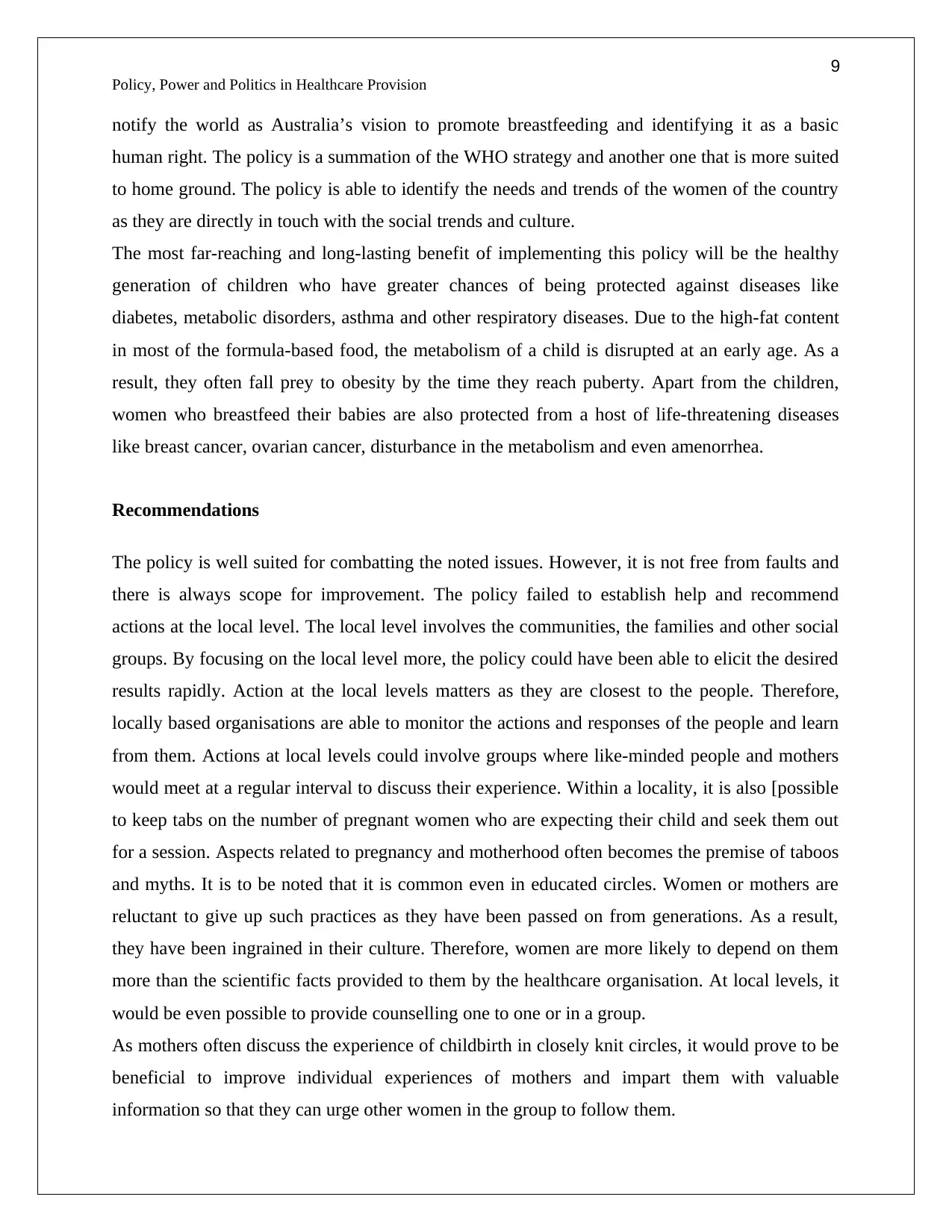
9
Policy, Power and Politics in Healthcare Provision
notify the world as Australia’s vision to promote breastfeeding and identifying it as a basic
human right. The policy is a summation of the WHO strategy and another one that is more suited
to home ground. The policy is able to identify the needs and trends of the women of the country
as they are directly in touch with the social trends and culture.
The most far-reaching and long-lasting benefit of implementing this policy will be the healthy
generation of children who have greater chances of being protected against diseases like
diabetes, metabolic disorders, asthma and other respiratory diseases. Due to the high-fat content
in most of the formula-based food, the metabolism of a child is disrupted at an early age. As a
result, they often fall prey to obesity by the time they reach puberty. Apart from the children,
women who breastfeed their babies are also protected from a host of life-threatening diseases
like breast cancer, ovarian cancer, disturbance in the metabolism and even amenorrhea.
Recommendations
The policy is well suited for combatting the noted issues. However, it is not free from faults and
there is always scope for improvement. The policy failed to establish help and recommend
actions at the local level. The local level involves the communities, the families and other social
groups. By focusing on the local level more, the policy could have been able to elicit the desired
results rapidly. Action at the local levels matters as they are closest to the people. Therefore,
locally based organisations are able to monitor the actions and responses of the people and learn
from them. Actions at local levels could involve groups where like-minded people and mothers
would meet at a regular interval to discuss their experience. Within a locality, it is also [possible
to keep tabs on the number of pregnant women who are expecting their child and seek them out
for a session. Aspects related to pregnancy and motherhood often becomes the premise of taboos
and myths. It is to be noted that it is common even in educated circles. Women or mothers are
reluctant to give up such practices as they have been passed on from generations. As a result,
they have been ingrained in their culture. Therefore, women are more likely to depend on them
more than the scientific facts provided to them by the healthcare organisation. At local levels, it
would be even possible to provide counselling one to one or in a group.
As mothers often discuss the experience of childbirth in closely knit circles, it would prove to be
beneficial to improve individual experiences of mothers and impart them with valuable
information so that they can urge other women in the group to follow them.
Policy, Power and Politics in Healthcare Provision
notify the world as Australia’s vision to promote breastfeeding and identifying it as a basic
human right. The policy is a summation of the WHO strategy and another one that is more suited
to home ground. The policy is able to identify the needs and trends of the women of the country
as they are directly in touch with the social trends and culture.
The most far-reaching and long-lasting benefit of implementing this policy will be the healthy
generation of children who have greater chances of being protected against diseases like
diabetes, metabolic disorders, asthma and other respiratory diseases. Due to the high-fat content
in most of the formula-based food, the metabolism of a child is disrupted at an early age. As a
result, they often fall prey to obesity by the time they reach puberty. Apart from the children,
women who breastfeed their babies are also protected from a host of life-threatening diseases
like breast cancer, ovarian cancer, disturbance in the metabolism and even amenorrhea.
Recommendations
The policy is well suited for combatting the noted issues. However, it is not free from faults and
there is always scope for improvement. The policy failed to establish help and recommend
actions at the local level. The local level involves the communities, the families and other social
groups. By focusing on the local level more, the policy could have been able to elicit the desired
results rapidly. Action at the local levels matters as they are closest to the people. Therefore,
locally based organisations are able to monitor the actions and responses of the people and learn
from them. Actions at local levels could involve groups where like-minded people and mothers
would meet at a regular interval to discuss their experience. Within a locality, it is also [possible
to keep tabs on the number of pregnant women who are expecting their child and seek them out
for a session. Aspects related to pregnancy and motherhood often becomes the premise of taboos
and myths. It is to be noted that it is common even in educated circles. Women or mothers are
reluctant to give up such practices as they have been passed on from generations. As a result,
they have been ingrained in their culture. Therefore, women are more likely to depend on them
more than the scientific facts provided to them by the healthcare organisation. At local levels, it
would be even possible to provide counselling one to one or in a group.
As mothers often discuss the experience of childbirth in closely knit circles, it would prove to be
beneficial to improve individual experiences of mothers and impart them with valuable
information so that they can urge other women in the group to follow them.
Paraphrase This Document
Need a fresh take? Get an instant paraphrase of this document with our AI Paraphraser
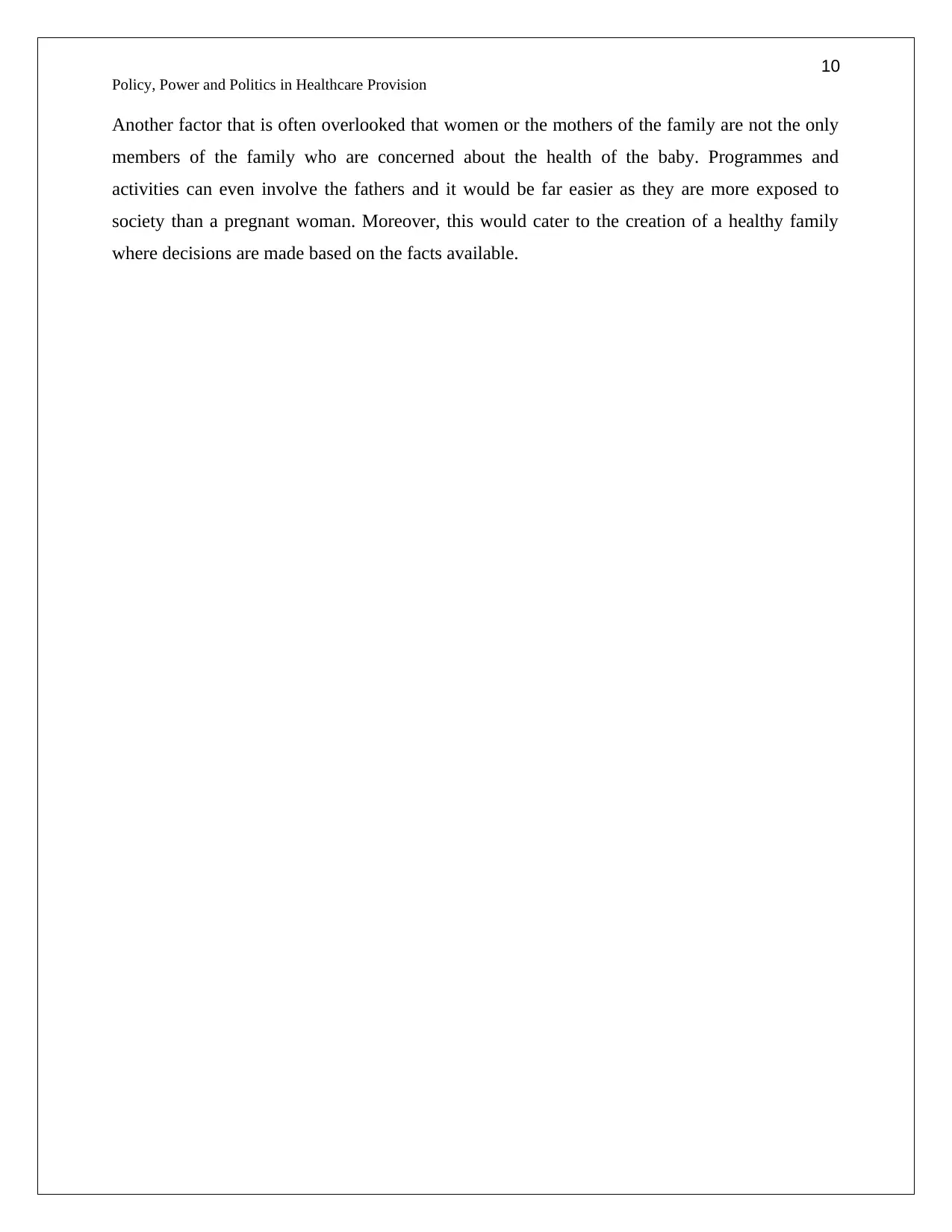
10
Policy, Power and Politics in Healthcare Provision
Another factor that is often overlooked that women or the mothers of the family are not the only
members of the family who are concerned about the health of the baby. Programmes and
activities can even involve the fathers and it would be far easier as they are more exposed to
society than a pregnant woman. Moreover, this would cater to the creation of a healthy family
where decisions are made based on the facts available.
Policy, Power and Politics in Healthcare Provision
Another factor that is often overlooked that women or the mothers of the family are not the only
members of the family who are concerned about the health of the baby. Programmes and
activities can even involve the fathers and it would be far easier as they are more exposed to
society than a pregnant woman. Moreover, this would cater to the creation of a healthy family
where decisions are made based on the facts available.
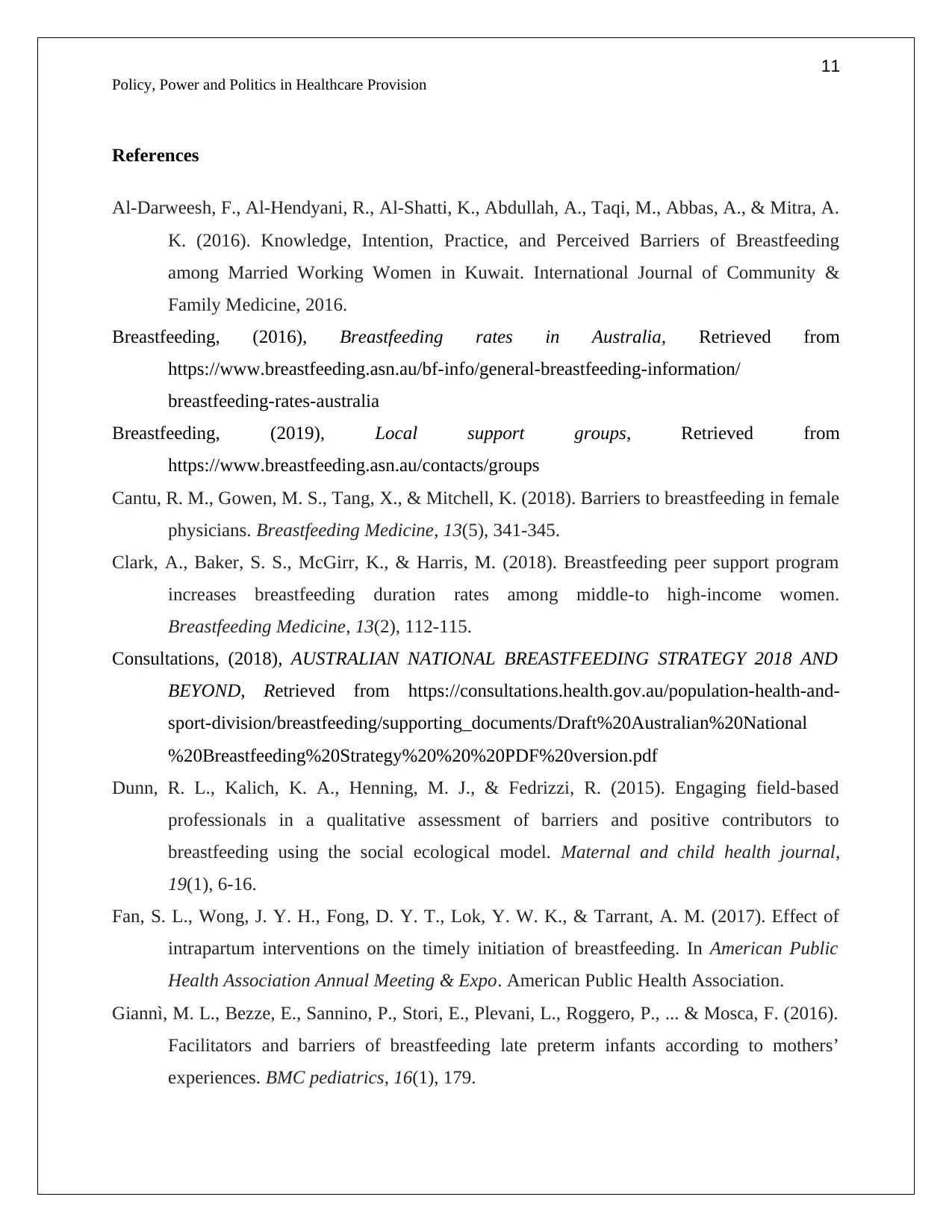
11
Policy, Power and Politics in Healthcare Provision
References
Al-Darweesh, F., Al-Hendyani, R., Al-Shatti, K., Abdullah, A., Taqi, M., Abbas, A., & Mitra, A.
K. (2016). Knowledge, Intention, Practice, and Perceived Barriers of Breastfeeding
among Married Working Women in Kuwait. International Journal of Community &
Family Medicine, 2016.
Breastfeeding, (2016), Breastfeeding rates in Australia, Retrieved from
https://www.breastfeeding.asn.au/bf-info/general-breastfeeding-information/
breastfeeding-rates-australia
Breastfeeding, (2019), Local support groups, Retrieved from
https://www.breastfeeding.asn.au/contacts/groups
Cantu, R. M., Gowen, M. S., Tang, X., & Mitchell, K. (2018). Barriers to breastfeeding in female
physicians. Breastfeeding Medicine, 13(5), 341-345.
Clark, A., Baker, S. S., McGirr, K., & Harris, M. (2018). Breastfeeding peer support program
increases breastfeeding duration rates among middle-to high-income women.
Breastfeeding Medicine, 13(2), 112-115.
Consultations, (2018), AUSTRALIAN NATIONAL BREASTFEEDING STRATEGY 2018 AND
BEYOND, Retrieved from https://consultations.health.gov.au/population-health-and-
sport-division/breastfeeding/supporting_documents/Draft%20Australian%20National
%20Breastfeeding%20Strategy%20%20%20PDF%20version.pdf
Dunn, R. L., Kalich, K. A., Henning, M. J., & Fedrizzi, R. (2015). Engaging field-based
professionals in a qualitative assessment of barriers and positive contributors to
breastfeeding using the social ecological model. Maternal and child health journal,
19(1), 6-16.
Fan, S. L., Wong, J. Y. H., Fong, D. Y. T., Lok, Y. W. K., & Tarrant, A. M. (2017). Effect of
intrapartum interventions on the timely initiation of breastfeeding. In American Public
Health Association Annual Meeting & Expo. American Public Health Association.
Giannì, M. L., Bezze, E., Sannino, P., Stori, E., Plevani, L., Roggero, P., ... & Mosca, F. (2016).
Facilitators and barriers of breastfeeding late preterm infants according to mothers’
experiences. BMC pediatrics, 16(1), 179.
Policy, Power and Politics in Healthcare Provision
References
Al-Darweesh, F., Al-Hendyani, R., Al-Shatti, K., Abdullah, A., Taqi, M., Abbas, A., & Mitra, A.
K. (2016). Knowledge, Intention, Practice, and Perceived Barriers of Breastfeeding
among Married Working Women in Kuwait. International Journal of Community &
Family Medicine, 2016.
Breastfeeding, (2016), Breastfeeding rates in Australia, Retrieved from
https://www.breastfeeding.asn.au/bf-info/general-breastfeeding-information/
breastfeeding-rates-australia
Breastfeeding, (2019), Local support groups, Retrieved from
https://www.breastfeeding.asn.au/contacts/groups
Cantu, R. M., Gowen, M. S., Tang, X., & Mitchell, K. (2018). Barriers to breastfeeding in female
physicians. Breastfeeding Medicine, 13(5), 341-345.
Clark, A., Baker, S. S., McGirr, K., & Harris, M. (2018). Breastfeeding peer support program
increases breastfeeding duration rates among middle-to high-income women.
Breastfeeding Medicine, 13(2), 112-115.
Consultations, (2018), AUSTRALIAN NATIONAL BREASTFEEDING STRATEGY 2018 AND
BEYOND, Retrieved from https://consultations.health.gov.au/population-health-and-
sport-division/breastfeeding/supporting_documents/Draft%20Australian%20National
%20Breastfeeding%20Strategy%20%20%20PDF%20version.pdf
Dunn, R. L., Kalich, K. A., Henning, M. J., & Fedrizzi, R. (2015). Engaging field-based
professionals in a qualitative assessment of barriers and positive contributors to
breastfeeding using the social ecological model. Maternal and child health journal,
19(1), 6-16.
Fan, S. L., Wong, J. Y. H., Fong, D. Y. T., Lok, Y. W. K., & Tarrant, A. M. (2017). Effect of
intrapartum interventions on the timely initiation of breastfeeding. In American Public
Health Association Annual Meeting & Expo. American Public Health Association.
Giannì, M. L., Bezze, E., Sannino, P., Stori, E., Plevani, L., Roggero, P., ... & Mosca, F. (2016).
Facilitators and barriers of breastfeeding late preterm infants according to mothers’
experiences. BMC pediatrics, 16(1), 179.
⊘ This is a preview!⊘
Do you want full access?
Subscribe today to unlock all pages.

Trusted by 1+ million students worldwide
1 out of 14
Related Documents
Your All-in-One AI-Powered Toolkit for Academic Success.
+13062052269
info@desklib.com
Available 24*7 on WhatsApp / Email
![[object Object]](/_next/static/media/star-bottom.7253800d.svg)
Unlock your academic potential
Copyright © 2020–2025 A2Z Services. All Rights Reserved. Developed and managed by ZUCOL.





